John and Mable Ringling Museum of Art
The John and Mable Ringling Museum of Art is the state art museum of Florida, located in Sarasota, Florida.[2] It was established in 1927 as the legacy of Mable Burton Ringling and John Ringling for the people of Florida. Florida State University assumed governance of the Museum in 2000.[3]
 | |
 Location within Florida | |
| Location |
|
|---|---|
| Coordinates | 27°22′59″N 82°33′33″W |
| Type | Art museum |
| Architect | John H. Phillips[1] |
| Public transit access | Sarasota County Area Transit |
| Website | ringling |
Designated as the official state art museum for Florida,[4] the institution offers twenty-one galleries of European paintings as well as Cypriot antiquities and Asian, American, and contemporary art. The museum's art collection currently consists of more than 10,000 objects that include a variety of paintings, sculpture, drawings, prints, photographs, and decorative arts from ancient through contemporary periods and from around the world. The most celebrated items in the museum are 16th–20th-century European paintings, including a world-renowned collection of Peter Paul Rubens paintings.[5] Other artists represented include Benjamin West, Marcel Duchamp, Diego Velázquez, Paolo Veronese, Rosa Bonheur, Gianlorenzo Bernini, Giuliano Finelli, Lucas Cranach the Elder, Frans Hals, Nicolas Poussin, Joseph Wright of Derby, Thomas Gainsborough, Eugène Boudin, and Benedetto Pagni.
In all, more than 150,000 square feet (14,000 m2) have been added to the campus, which includes the art museum, circus museum, and Ca' d'Zan, the Ringlings' mansion, which has been restored, along with the historic Asolo Theater. New additions to the campus include the Visitor's Pavilion, the Education, Library, and Conservation Complex, the Tibbals Learning Center complete with a miniature circus, and the Searing Wing, a 30,000-square-foot (2,800 m2) gallery for special exhibitions attached to the art museum.[6]
History
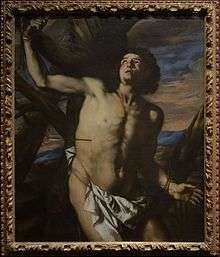
A. Everett (Chick) Austin Jr., a member of the International Brotherhood of Magicians and, from 1927 to 1944, the innovative director of the Wadsworth Atheneum, was the Ringling Museum's first director.[7]
John Ringling willed his property and art collection, plus a $1.2 million endowment, to the people of State of Florida upon his death in 1936. One instruction of the will states that no one has permission to ever change the official name of the museum. For the next 10 years the museum was opened irregularly and not maintained professionally, Ca' d'Zan was not opened to the public, while the State fought with Ringling's creditors over the estate (Ringling was nearly bankrupt at his death; Florida would finally prevail in court in 1946). Even after prevailing in court, the Florida Department of State (who had initial responsibility for the Museum) did virtually nothing to manage the endowment or maintain the property, while the local community (believing the Museum to be the State's responsibility) did little to support the Museum. By the late 1990s Ca' d'Zan was falling apart (as were the exterior footpaths and roads), the Museum had a serious roof leak plus its security systems were wholly inadequate to protect its collection, and the Asolo Theater building was actually condemned, while the $1.2 million endowment had grown to only $2 million.[8]
The State of Florida transferred responsibility of the Museum to Florida State University in 2000.[3] As part of the reorganization it created a Board of Trustees consisting of no more than 31 members, of which at least one-third must be residents of either Manatee or Sarasota counties.[9]
In 2002 it appropriated $42.9 million in construction funds, with one condition: the Museum had to raise $50 million in private sector support within five years; the Museum raised $55 million by the deadline.[8]
In January 2007, a $76-million expansion and renovation of the Museum of Art was finished. A new Arthur F. and Ulla R. Searing Wing was added—the new wing being the final component of a five-year master plan that has transformed the museum. It is now the sixteenth largest in the United States.[6]
In 2013, The John and Mable Ringling Museum of Art was renamed The Ringling.
Ringling Estate
Aside from the art museum, the estate also contains the Ringling's mansion, Ca' d'Zan, Mable Ringling's rose garden, the Circus Museum and Tibbals Learning Center, the historic Asolo Theater, the Ringling Art Library, the Secret Garden, gravesite of John and Mable Ringling and the FSU Center for the Performing Arts.
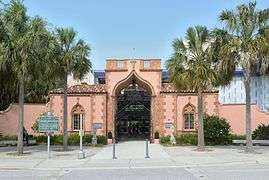 Main entrance
Main entrance Aerial view of The John and Mable Ringling Museum of Art Courtyard
Aerial view of The John and Mable Ringling Museum of Art Courtyard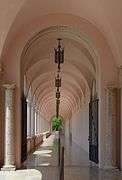 Museum of Art Loggia
Museum of Art Loggia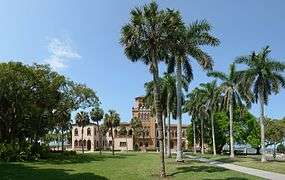 Ca' d'Zan
Ca' d'Zan Statues courtyard
Statues courtyard
Dwarf Garden
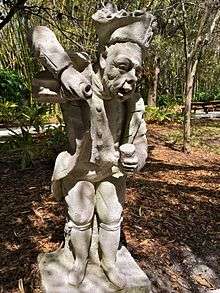
The Dwarf Garden showcases stone statues that the Ringlings brought back with them during their years of travel in Europe.
Ca' d'Zan
Ca' d'Zan, (Venetian for "House of John"), is the waterfront residence built for Mable and John Ringling. The mansion was designed by architect Dwight James Baum with assistance from the Ringlings, built by Owen Burns, and was completed in 1926.
It is designed in Venetian Gothic style. Overlooking Sarasota Bay, the mansion became the center for cultural life in Sarasota for several years.[10] The residence was restored in 2002.
Rose Garden
Mable Ringling’s rose garden was completed in 1913 while she and John were living in another house on the property. The rose garden is located near the original Mary Louise and Charles N. Thompson residence within the beautifully landscaped grounds overlooking Sarasota Bay. John and Mable are both buried very near this garden, just to the north, in what is called the Secret Garden.
Circus Museum and the Tibbals Learning Center
The Circus Museum, established in 1948, is the first museum of its kind to document the history of the circus. The museum has a collection of handbills, posters and art prints, circus paper, business records, wardrobe, performing props, circus equipment, and parade wagons. The adjacent Tibbals Learning Center contains The Howard Bros. Circus model. Built by Howard Tibbals, this ¾-inch-to-the-foot scale model display is inspired by the Ringling Bros. and Barnum & Bailey Circus from 1919–1938, and is billed as the "world's largest miniature circus"[11]
The Wisconsin
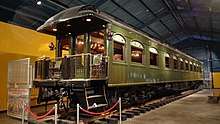
John Ringling owned a private railroad observation passenger car and used it from 1905 until 1917 to travel with his circus, take vacations, and conduct business trips. It was built by the George Mortimer Pullman Company in Pullman, Illinois. It was made of wood. It weighed 65 tons, was 79 feet long, 14 feet tall and 10 feet wide. It cost $11,325.23, this was only about half the price of a comparable Pullman car of the time, because it was outfitted with walls taken from other railroad cars. He named it for his home state of Wisconsin, and because that is where his circus was quartered.
The car was divided into an observation room, three staterooms, dining room, kitchen, bathroom, and servants’ quarters. The interior was made of mahogany and other woods, intricate moldings, gold-leaf stencils, and stained glass. The 10-foot high ceilings were painted viva gold, baize green, and fiery brown. When New York City banned wooden cars from its city’s tunnels, John Ringling decided to sell the Wisconsin. Later, the car was purchased by the Norfolk Southern Railroad, which renamed it the Virginia, it used it as a business car for its railroad officials. Then it was sold to the Atlantic & East Carolina Railway, which adapted it into a fishing lodge, renamed it the Carolina, and placed it in Morehead City, North Carolina.
It was acquired by the North Carolina Transportation Museum which kept it in covered storage on its grounds in Spencer. A $417,240 federal grant awarded to the Florida Department of Transportation helped pay for the restoration of the Wisconsin's exterior, carried out by the Edwards Rail Car Co. in Montgomery, Ala. The next stop for the railcar was The John and Mable Ringling Museum in Sarasota Florida. An anonymous donation of $100,000 then brought the Wisconsin's interiors back to its Gilded Age sheen, work which was done right at the museum. The Sarasota County Parks and Recreation Department donated railroad tracks for the train car. The tracks became available as part of the Rails to Trails project. The rails were laid by volunteers from the Florida Railroad Museum located in Parrish, Florida.
Ringling Art Library
The Ringling Art Library is one of the largest art reference libraries in the southeastern United States.[12] The collection of nearly 90,000 volumes includes some 800 books originally owned by John Ringling himself. The collection covers the 16th-21st centuries and topics like fine and decorative art, art history, architecture, fashion, and theater.[12] The Library hosts a free book club, the Literati Book Club, which discusses famous authors & art history.[13] Each month, the Literati Book Club offers two meetings at which the same book is discussed; on one day the meeting is in the evening and the other day the meeting is in the morning.[13] Other regular events include a Saturday for Educators Workshop series which is designed to enhance educators’ understanding of The Ringling’s collections and special exhibitions, while also providing an opportunity for networking, collaboration, and inspiration.[14] The Ringling Art Library also hosts an online blog.[15] The library is open to the public and there is a reading room for patrons to view and use materials; however, the collection is non-circulating and items cannot be checked out.[16]
The Secret Garden
In 1991, John, Mable and his sister, Ida Ringling North, were buried on the property just in front and to the right of the Ca' d'Zan. It is called the secret garden and John is buried between the two women. There is a locked gate around the 3 graves and tombstones. There is a garden and statues in front of the gate. During the day, during visiting hours, the gate is unlocked and opened. On the anniversary of John Ringling's birthday, neighboring New College students will often sneak in and place a cigar on John's grave.
References
- "History of The Museum of Art". The John and Mable Ringling Museum of Art. Florida State University. Retrieved August 27, 2019.
- "Title XLVIII, 1004.45(2)(a) 2006 Florida Statutes". Archived from the original on 2016-02-01. Retrieved 2015-09-16.
- FSU article, 06/28/2004. Archived December 8, 2006, at the Wayback Machine
- "The Ringling". Retrieved March 17, 2014.
- "Peter Paul Rubens, Paintings in Museums and Public Art Galleries". ArtCyclopedia.com. Retrieved 2007-05-02.
- "A vision rebuilt". St. Pete Times. Retrieved 4 September 2015.
- "The Ringling Circus Museum Collections: An Overview".
- "About". The Ringling. 2000-07-01. Archived from the original on 2009-02-03. Retrieved 2014-03-17.
- "Board of Directors". The Ringling. Archived from the original on 2010-10-26. Retrieved 2014-03-17.
- John and Mable Ringling Museum of Art. "Ca' d'Zan Mansion".
- John and Mable Ringling Museum of Art. "Circus Museum".
- "Education Center: Art Library". The Ringling. The John and Mable Ringling Museum of Art. Retrieved 20 November 2016.
- "Programs: Literati Book Club". The Ringling. The John and Mable Ringling Museum of Art. Retrieved 20 November 2016.
- Time: 9:00am – 1:00pm (2013-11-02). "Saturday for Educators: Icons of Style". The Ringling. Retrieved 2014-03-17.
- "The Ringling Art Library". Ringlingmuseumlibrary.wordpress.com. Retrieved 2014-03-17.
- "Library Faq". The Ringling. Retrieved 4 September 2015.
External links
| Wikimedia Commons has media related to John and Mable Ringling Museum of Art. |